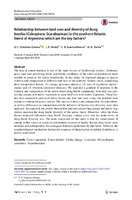| dc.creator | Giménez Gómez, Victoria Carolina | |
| dc.creator | Verdú Faraco, José Ramón | |
| dc.creator | Guerra Alonso, Celeste Beatríz | |
| dc.creator | Zurita, Gustavo Andrés | |
| dc.date.accessioned | 2022-12-09T13:54:58Z | |
| dc.date.available | 2022-12-09T13:54:58Z | |
| dc.date.issued | 2018-07-26 | |
| dc.identifier.issn | 1572-971 | |
| dc.identifier.other | CCPI-FCF-A-008 | |
| dc.identifier.other | 6803 | |
| dc.identifier.uri | https://hdl.handle.net/20.500.12219/3970 | |
| dc.description | Fil: Giménez Gómez, Victoria Carolina. Consejo Nacional de Investigaciones Científicas y Técnicas. Centro Científico Tecnológico Nordeste; Argentina. | es_AR |
| dc.description | Fil: Giménez Gómez, Victoria Carolina. Consejo Nacional de Investigaciones Científicas y Técnicas. Instituto de Biología Subtropical; Argentina. | es_AR |
| dc.description | Fil: Giménez Gómez, Victoria Carolina. Consejo Nacional de Investigaciones Científicas y Técnicas. Instituto de Biología Subtropical. Nodo Puerto Iguazú; Argentina. | es_AR |
| dc.description | Fil: Giménez Gómez, Victoria Carolina. Universidad Nacional de Misiones. Instituto de Biología Subtropical. Nodo Puerto Iguazú; Argentina. | es_AR |
| dc.description | Fil: Verdú Faraco, José Ramón. Universidad de Alicante. Instituto Universitario de Investigación. Centro Iberoamericano de la Biodiversidad; España. | es_AR |
| dc.description | Fil: Guerra Alonso, Celeste Beatriz. Consejo Nacional de Investigaciones Científicas y Técnicas. Centro Científico Tecnológico Nordeste; Argentina. | es_AR |
| dc.description | Fil: Guerra Alonso, Celeste Beatriz. Consejo Nacional de Investigaciones Científicas y Técnicas. Instituto de Biología Subtropical. Nodo Puerto Iguazú; Argentina. | es_AR |
| dc.description | Fil: Guerra Alonso, Celeste Beatriz. Universidad Nacional de Misiones. Instituto de Biología Subtropical. Nodo Puerto Iguazú; Argentina. | es_AR |
| dc.description | Fil: Zurita, Gustavo Andrés. Consejo Nacional de Investigaciones Científicas y Técnicas. Centro Científico Tecnológico Nordeste; Argentina. | es_AR |
| dc.description | Fil: Zurita, Gustavo Andrés. Consejo Nacional de Investigaciones Científicas y Técnicas. Instituto de Biología Subtropical. Nodo Puerto Iguazú; Argentina. | es_AR |
| dc.description | Fil: Zurita, Gustavo Andrés. Universidad Nacional de Misiones. Instituto de Biología Subtropical. Nodo Puerto Iguazú; Argentina. | es_AR |
| dc.description | Fil: Zurita, Gustavo Andrés. Universidad Nacional de Misiones. Facultad de Ciencias Forestales; Argentina. | es_AR |
| dc.description.abstract | The loss of natural habitats is one of the main drivers of biodiversity decline. Anthropogenic land uses preserving biotic and abiotic conditions of the native ecosystem are more suitable to preserve the native biodiversity. In this study, we explored changes in species richness and composition in different land uses of the southern Atlantic forest, considering three independent factors: (1) canopy (presence–absence), (2) type of vegetation (native–exotic) and (3) livestock (presence–absence). We expected a gradient of response in the richness and composition of the native forest dung beetle community, from land uses preserving canopy and native vegetation to open land uses with exotic vegetation. Dung beetles were sampled in protected native forests and four land uses, using two potential food resources: human dung and carrion. The species richness and composition of each habitat, as well as differences in composition and the influence of factors over diversity, were then analyzed. As expected, our results showed that land uses preserving canopy and native vegetation maintain the dung beetle diversity of the native forest. Moreover, while the three factors analyzed influenced dung beetle diversity, canopy cover was the main driver of dung beetle diversity loss. The main conclusion of this study is that the conservation of canopy (either native or exotic) is determinant to preserve highly diverse dung beetle communities and subsequently, the ecological functions performed by this taxon. However, the ecophysiological mechanism behind the response of dung beetles to habitat disturbance is poorly understood. | en |
| dc.format | application/pdf | |
| dc.format.extent | 945.5 KB | |
| dc.language.iso | eng | en |
| dc.publisher | Springer International Publishing Switzerland | |
| dc.relation | info:eu-repo/semantics/altIdentifier/urn/https://link.springer.com/article/10.1007/s10531-018-1597-8 | |
| dc.relation | info:eu-repo/semantics/altIdentifier/doi/https://doi.org/10.1007/s10531-018-1597-8 | |
| dc.rights | info:eu-repo/semantics/openAccess | |
| dc.rights.uri | http://creativecommons.org/licenses/by-nc-sa/4.0/ | |
| dc.subject | Cover vegetation | en |
| dc.subject | Forest habitat | en |
| dc.subject | Global change | en |
| dc.subject | Livestock | en |
| dc.subject | Microclimatic conditions | en |
| dc.subject | Scarabaeoidea | en |
| dc.title | Relationship between land uses and diversity of dung beetles (Coleoptera: Scarabaeinae) in the southern Atlantic forest of Argentina: which are the key factors? | en |
| dc.type | info:eu-repo/semantics/article | |
| dc.type | info:ar-repo/semantics/artículo | |
| dc.type | info:eu-repo/semantics/publishedVersion | |




